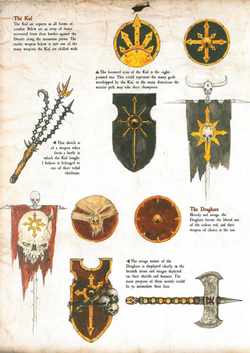
The icon of the Kul tribe as depicted in Total War: Warhammer III.[3]
The Kul are among the greatest of the Kurgan tribes. They stake their claim on the lands of the Eastern Steppes and the Chaos Wastes above the Worlds Edge Mountains and to the east of the Sea of Chaos, from where they launch brutal raids on their neighbouring tribes, sometimes travelling as far as Grand Cathay or the Empire in their quest for plunder. Approximately to the north of them are the draghar tribe.[1][2a]
History[]

A Marauding warrior of the Kul[2a]
The Kul are ruthless raiders and plunderers, even more so than other Kurgan, and they constantly roam the lands of the northeastern Known World, attacking where the spoils are richest and the foes most dangerous. They are known as slave-takers, and most who know of the Kul would rather die in the initial attack than be taken as one of their tortured slaves. They have no qualms about attacking other Kurgan tribes, for the Kurgan title is more a collective term that outsiders apply to them -- the Kul are loyal ultimately only to other Kul.[2a]

Commonly employed symbols of the Kul and Draghar tribes of the Kurgan.[2b]
The Kul respect personal combat above all else, and they excel at various forms of warfare -- they swiftly become experts with any weapon they encounter, and being nomadic, they have encountered many. From sword and axe, to unarmed combat through to more obscure Far Eastern blades, the Kul are undisputed martial experts.[2a]
By tradition, the Kul do not worship any one particular god, but prefer to pay homage to a great conglomeration of fell deities. They see this as having a power of its own, and one has to admire their simple logic in this regard -- the Kul believe that if you pray to a hundred gods, then the chances of one of them listening is much greater than if you are praying to only one.[2a]
The favoured icon of the Kul is the eight-pointed star, which usually represents Chaos. For the Kul this icon could represent the many gods they worshipped, or the many directions the warrior path may take their champions.[2b]
Notable Kul[]
- Asavar Kul - The twelfth Everchosen of the Chaos Gods who led the forces of Chaos against the nations of the Old World during the Great War Against Chaos from 2301 to 2304 IC.
- Vardek Crom the Conqueror - The Herald of Archaon, the thirteenth Everchosen, and current chieftain of the Kul.
- Akkorak the Crow - The Reaver of the Nine Wastes.
